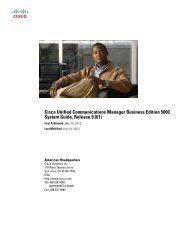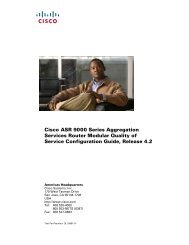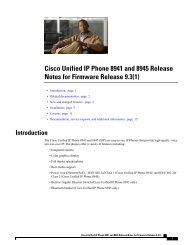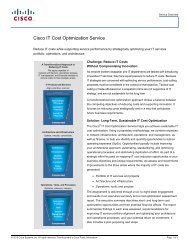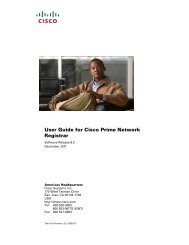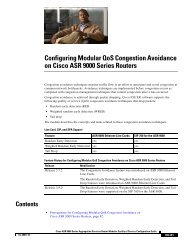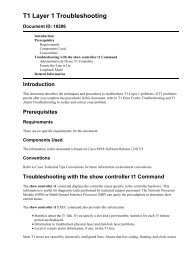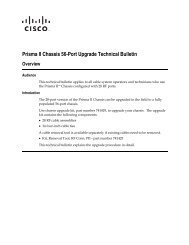- Page 1 and 2:
CHAPTER2Catalyst 3750-E and 3560-E
- Page 3 and 4:
Chapter 2Catalyst 3750-E and 3560-E
- Page 5 and 6:
Chapter 2Catalyst 3750-E and 3560-E
- Page 7 and 8:
Chapter 2Catalyst 3750-E and 3560-E
- Page 9 and 10:
Chapter 2Catalyst 3750-E and 3560-E
- Page 11 and 12:
Chapter 2Catalyst 3750-E and 3560-E
- Page 13:
Chapter 2Catalyst 3750-E and 3560-E
- Page 17 and 18:
Chapter 2Catalyst 3750-E and 3560-E
- Page 19 and 20:
Chapter 2Catalyst 3750-E and 3560-E
- Page 21 and 22:
Chapter 2Catalyst 3750-E and 3560-E
- Page 23 and 24:
Chapter 2Catalyst 3750-E and 3560-E
- Page 25 and 26:
Chapter 2Catalyst 3750-E and 3560-E
- Page 27 and 28:
Chapter 2Catalyst 3750-E and 3560-E
- Page 29 and 30:
Chapter 2Catalyst 3750-E and 3560-E
- Page 31 and 32:
Chapter 2Catalyst 3750-E and 3560-E
- Page 33 and 34:
Chapter 2Catalyst 3750-E and 3560-E
- Page 35 and 36:
Chapter 2Catalyst 3750-E and 3560-E
- Page 37 and 38:
Chapter 2Catalyst 3750-E and 3560-E
- Page 39 and 40:
Chapter 2Catalyst 3750-E and 3560-E
- Page 41 and 42:
Chapter 2Catalyst 3750-E and 3560-E
- Page 43 and 44:
Chapter 2Catalyst 3750-E and 3560-E
- Page 45 and 46:
Chapter 2Catalyst 3750-E and 3560-E
- Page 47 and 48:
Chapter 2Catalyst 3750-E and 3560-E
- Page 49 and 50:
Chapter 2Catalyst 3750-E and 3560-E
- Page 51 and 52:
Chapter 2Catalyst 3750-E and 3560-E
- Page 53 and 54:
Chapter 2Catalyst 3750-E and 3560-E
- Page 55 and 56:
Chapter 2Catalyst 3750-E and 3560-E
- Page 57 and 58:
Chapter 2Catalyst 3750-E and 3560-E
- Page 59 and 60:
Chapter 2Catalyst 3750-E and 3560-E
- Page 61 and 62:
Chapter 2Catalyst 3750-E and 3560-E
- Page 63 and 64:
Chapter 2Catalyst 3750-E and 3560-E
- Page 65 and 66:
Chapter 2Catalyst 3750-E and 3560-E
- Page 67 and 68:
Chapter 2Catalyst 3750-E and 3560-E
- Page 69 and 70:
Chapter 2Catalyst 3750-E and 3560-E
- Page 71 and 72:
Chapter 2Catalyst 3750-E and 3560-E
- Page 73 and 74:
Chapter 2Catalyst 3750-E and 3560-E
- Page 75 and 76:
Chapter 2Catalyst 3750-E and 3560-E
- Page 77 and 78:
Chapter 2Catalyst 3750-E and 3560-E
- Page 79 and 80:
Chapter 2Catalyst 3750-E and 3560-E
- Page 81 and 82:
Chapter 2Catalyst 3750-E and 3560-E
- Page 83 and 84:
Chapter 2Catalyst 3750-E and 3560-E
- Page 85 and 86:
Chapter 2Catalyst 3750-E and 3560-E
- Page 87 and 88:
Chapter 2Catalyst 3750-E and 3560-E
- Page 89 and 90:
Chapter 2Catalyst 3750-E and 3560-E
- Page 91 and 92:
Chapter 2Catalyst 3750-E and 3560-E
- Page 93 and 94:
Chapter 2Catalyst 3750-E and 3560-E
- Page 95 and 96:
Chapter 2Catalyst 3750-E and 3560-E
- Page 97 and 98:
Chapter 2Catalyst 3750-E and 3560-E
- Page 99 and 100:
Chapter 2Catalyst 3750-E and 3560-E
- Page 101 and 102:
Chapter 2Catalyst 3750-E and 3560-E
- Page 103 and 104:
Chapter 2Catalyst 3750-E and 3560-E
- Page 105 and 106:
Chapter 2Catalyst 3750-E and 3560-E
- Page 107 and 108:
Chapter 2Catalyst 3750-E and 3560-E
- Page 109 and 110:
Chapter 2Catalyst 3750-E and 3560-E
- Page 111 and 112:
Chapter 2Catalyst 3750-E and 3560-E
- Page 113 and 114:
Chapter 2Catalyst 3750-E and 3560-E
- Page 115 and 116:
Chapter 2Catalyst 3750-E and 3560-E
- Page 117 and 118:
Chapter 2Catalyst 3750-E and 3560-E
- Page 119 and 120:
Chapter 2Catalyst 3750-E and 3560-E
- Page 121 and 122:
Chapter 2Catalyst 3750-E and 3560-E
- Page 123 and 124:
Chapter 2Catalyst 3750-E and 3560-E
- Page 125 and 126:
Chapter 2Catalyst 3750-E and 3560-E
- Page 127 and 128:
Chapter 2Catalyst 3750-E and 3560-E
- Page 129 and 130:
Chapter 2Catalyst 3750-E and 3560-E
- Page 131 and 132:
Chapter 2Catalyst 3750-E and 3560-E
- Page 133 and 134:
Chapter 2Catalyst 3750-E and 3560-E
- Page 135 and 136:
Chapter 2Catalyst 3750-E and 3560-E
- Page 137 and 138:
Chapter 2Catalyst 3750-E and 3560-E
- Page 139 and 140:
Chapter 2Catalyst 3750-E and 3560-E
- Page 141 and 142:
Chapter 2Catalyst 3750-E and 3560-E
- Page 143 and 144:
Chapter 2Catalyst 3750-E and 3560-E
- Page 145 and 146:
Chapter 2Catalyst 3750-E and 3560-E
- Page 147 and 148:
Chapter 2Catalyst 3750-E and 3560-E
- Page 149 and 150:
Chapter 2Catalyst 3750-E and 3560-E
- Page 151 and 152:
Chapter 2Catalyst 3750-E and 3560-E
- Page 153 and 154:
Chapter 2Catalyst 3750-E and 3560-E
- Page 156 and 157:
dot1x critical (global configuratio
- Page 158 and 159:
dot1x critical (interface configura
- Page 160 and 161:
dot1x fallbackChapter 2Catalyst 375
- Page 162 and 163:
dot1x guest-vlanChapter 2Catalyst 3
- Page 164 and 165:
dot1x initializeChapter 2Catalyst 3
- Page 166 and 167:
dot1x mac-auth-bypassChapter 2Catal
- Page 168 and 169:
dot1x max-reauth-reqChapter 2Cataly
- Page 170 and 171:
dot1x paeChapter 2Catalyst 3750-E a
- Page 172 and 173:
dot1x port-controlChapter 2Catalyst
- Page 174 and 175:
dot1x reauthenticationChapter 2Cata
- Page 176 and 177:
dot1x test eapol-capableChapter 2Ca
- Page 178 and 179:
dot1x timeoutChapter 2Catalyst 3750
- Page 180 and 181:
dot1x timeoutChapter 2Catalyst 3750
- Page 182 and 183:
duplexChapter 2Catalyst 3750-E and
- Page 184 and 185:
epm access-controlChapter 2Catalyst
- Page 186 and 187:
errdisable detect causeChapter 2Cat
- Page 188 and 189:
errdisable detect cause small-frame
- Page 190 and 191:
errdisable recoveryChapter 2Catalys
- Page 192 and 193:
errdisable recoveryChapter 2Catalys
- Page 194 and 195:
exception crashinfoChapter 2Catalys
- Page 196 and 197:
fallback profileChapter 2Catalyst 3
- Page 198 and 199:
flowcontrolChapter 2Catalyst 3750-E
- Page 200 and 201:
hw-moduleChapter 2Catalyst 3750-E a
- Page 202 and 203:
interface port-channelChapter 2Cata
- Page 204 and 205:
interface rangeChapter 2Catalyst 37
- Page 206 and 207:
interface vlanChapter 2Catalyst 375
- Page 208 and 209:
ip access-groupChapter 2Catalyst 37
- Page 210 and 211:
ip addressChapter 2Catalyst 3750-E
- Page 212 and 213:
ip admissionChapter 2Catalyst 3750-
- Page 214 and 215:
ip admission name proxy httpChapter
- Page 216 and 217:
ip arp inspection filter vlanChapte
- Page 218 and 219:
ip arp inspection limitChapter 2Cat
- Page 220 and 221:
ip arp inspection log-bufferChapter
- Page 222 and 223:
ip arp inspection trustChapter 2Cat
- Page 224 and 225:
ip arp inspection validateChapter 2
- Page 226 and 227:
ip arp inspection vlan loggingChapt
- Page 228 and 229:
ip device trackingChapter 2Catalyst
- Page 230 and 231:
ip device tracking probeChapter 2Ca
- Page 232 and 233:
ip dhcp snoopingChapter 2Catalyst 3
- Page 234 and 235:
ip dhcp snooping bindingChapter 2Ca
- Page 236 and 237:
ip dhcp snooping databaseChapter 2C
- Page 238 and 239:
ip dhcp snooping information option
- Page 240 and 241:
ip dhcp snooping information option
- Page 242 and 243:
ip dhcp snooping limit rateChapter
- Page 244 and 245:
ip dhcp snooping verifyChapter 2Cat
- Page 246 and 247:
ip dhcp snooping vlan information o
- Page 248 and 249:
ip igmp filterChapter 2Catalyst 375
- Page 250 and 251:
ip igmp max-groupsChapter 2Catalyst
- Page 252 and 253:
ip igmp profileChapter 2Catalyst 37
- Page 254 and 255:
ip igmp snoopingChapter 2Catalyst 3
- Page 256 and 257:
ip igmp snooping last-member-query-
- Page 258 and 259:
ip igmp snooping querierChapter 2Ca
- Page 260 and 261:
ip igmp snooping report-suppression
- Page 262 and 263:
ip igmp snooping tcnChapter 2Cataly
- Page 264 and 265:
ip igmp snooping tcn floodChapter 2
- Page 266 and 267:
ip igmp snooping vlan mrouterChapte
- Page 268 and 269:
ip igmp snooping vlan staticChapter
- Page 270 and 271:
ip snap forwardingChapter 2Catalyst
- Page 272 and 273:
ip source bindingChapter 2Catalyst
- Page 274 and 275:
ip sshChapter 2Catalyst 3750-E and
- Page 276 and 277:
ip sticky-arp (global configuration
- Page 278 and 279:
ip sticky-arp (interface configurat
- Page 280 and 281:
ip verify sourceChapter 2Catalyst 3
- Page 282 and 283:
ipv6 access-listChapter 2Catalyst 3
- Page 284 and 285:
ipv6 address dhcpChapter 2Catalyst
- Page 286 and 287:
ipv6 dhcp ping packetsChapter 2Cata
- Page 288 and 289:
ipv6 dhcp poolChapter 2Catalyst 375
- Page 290 and 291:
ipv6 dhcp poolChapter 2Catalyst 375
- Page 292 and 293:
ipv6 dhcp serverChapter 2Catalyst 3
- Page 294 and 295:
ipv6 mld snoopingChapter 2Catalyst
- Page 296 and 297:
ipv6 mld snooping last-listener-que
- Page 298 and 299:
ipv6 mld snooping last-listener-que
- Page 300 and 301:
ipv6 mld snooping robustness-variab
- Page 302 and 303:
ipv6 mld snooping tcnChapter 2Catal
- Page 304 and 305:
ipv6 mld snooping vlanChapter 2Cata
- Page 306 and 307:
ipv6 traffic-filterChapter 2Catalys
- Page 308 and 309:
l2protocol-tunnelChapter 2Catalyst
- Page 310 and 311:
l2protocol-tunnelChapter 2Catalyst
- Page 312 and 313:
lacp port-priorityChapter 2Catalyst
- Page 314 and 315:
lacp system-priorityChapter 2Cataly
- Page 316 and 317:
license bootChapter 2Catalyst 3750-
- Page 318 and 319:
link state groupChapter 2Catalyst 3
- Page 320 and 321:
link state trackChapter 2Catalyst 3
- Page 322 and 323:
location (global configuration)Chap
- Page 324 and 325:
location (interface configuration)C
- Page 326 and 327:
logging event power-inline-statusCh
- Page 328 and 329:
logging fileChapter 2Catalyst 3750-
- Page 330 and 331:
mab request format attribute 32Chap
- Page 332 and 333:
mac access-groupChapter 2Catalyst 3
- Page 334 and 335:
mac access-list extendedChapter 2Ca
- Page 336 and 337:
mac address-table learning vlanChap
- Page 338 and 339:
mac address-table move updateChapte
- Page 340 and 341:
mac address-table notificationChapt
- Page 342 and 343:
mac address-table staticChapter 2Ca
- Page 344 and 345:
mac address-table static dropChapte
- Page 346 and 347:
match (access-map configuration)Cha
- Page 348 and 349:
match (class-map configuration)Chap
- Page 350 and 351:
mdix autoChapter 2Catalyst 3750-E a
- Page 352 and 353:
mls qosChapter 2Catalyst 3750-E and
- Page 354 and 355:
mls qos aggregate-policerChapter 2C
- Page 356 and 357:
mls qos cosChapter 2Catalyst 3750-E
- Page 358 and 359:
mls qos dscp-mutationChapter 2Catal
- Page 360 and 361:
mls qos mapChapter 2Catalyst 3750-E
- Page 362 and 363:
mls qos mapChapter 2Catalyst 3750-E
- Page 364 and 365:
mls qos queue-set output buffersCha
- Page 366 and 367:
mls qos queue-set output thresholdC
- Page 368 and 369:
mls qos rewrite ip dscpChapter 2Cat
- Page 370 and 371: mls qos srr-queue input bandwidthCh
- Page 372 and 373: mls qos srr-queue input buffersChap
- Page 374 and 375: mls qos srr-queue input cos-mapChap
- Page 376 and 377: mls qos srr-queue input dscp-mapCha
- Page 378 and 379: mls qos srr-queue input priority-qu
- Page 380 and 381: mls qos srr-queue input thresholdCh
- Page 382 and 383: mls qos srr-queue output cos-mapCha
- Page 384 and 385: mls qos srr-queue output dscp-mapCh
- Page 386 and 387: mls qos trustChapter 2Catalyst 3750
- Page 388 and 389: mls qos vlan-basedChapter 2Catalyst
- Page 390 and 391: monitor sessionChapter 2Catalyst 37
- Page 392 and 393: monitor sessionChapter 2Catalyst 37
- Page 394 and 395: monitor sessionChapter 2Catalyst 37
- Page 396 and 397: mvr (global configuration)Chapter 2
- Page 398 and 399: mvr (interface configuration)Chapte
- Page 400 and 401: mvr (interface configuration)Chapte
- Page 402 and 403: network-policy profile (global conf
- Page 404 and 405: network-policy profile (network-pol
- Page 406 and 407: nmsp attachment suppressChapter 2Ca
- Page 408 and 409: no dot1x syslog verboseChapter 2Cat
- Page 410 and 411: nsfChapter 2Catalyst 3750-E and 356
- Page 412 and 413: pagp learn-methodChapter 2Catalyst
- Page 414 and 415: pagp port-priorityChapter 2Catalyst
- Page 416 and 417: permit (ARP access-list configurati
- Page 418 and 419: permit (IPv6 access-list configurat
- Page 422 and 423: permit (IPv6 access-list configurat
- Page 424 and 425: permit (MAC access-list configurati
- Page 426 and 427: permit (MAC access-list configurati
- Page 428 and 429: policeChapter 2Catalyst 3750-E and
- Page 430 and 431: police aggregateChapter 2Catalyst 3
- Page 432 and 433: policy-mapChapter 2Catalyst 3750-E
- Page 434 and 435: port-channel load-balanceChapter 2C
- Page 436 and 437: power inlineChapter 2Catalyst 3750-
- Page 438 and 439: power inlineChapter 2Catalyst 3750-
- Page 440 and 441: power inline consumptionChapter 2Ca
- Page 442 and 443: power inline policeChapter 2Catalys
- Page 444 and 445: power rpsChapter 2Catalyst 3750-E a
- Page 446 and 447: power supplyChapter 2Catalyst 3750-
- Page 448 and 449: priority-queueChapter 2Catalyst 375
- Page 450 and 451: private-vlanChapter 2Catalyst 3750-
- Page 452 and 453: private-vlanChapter 2Catalyst 3750-
- Page 454 and 455: private-vlan mappingChapter 2Cataly
- Page 456 and 457: adius-server dead-criteriaChapter 2
- Page 458 and 459: adius-server hostChapter 2Catalyst
- Page 460 and 461: commandChapter 2Catalyst 3750-E and
- Page 462 and 463: eloadChapter 2Catalyst 3750-E and 3
- Page 464 and 465: emote commandChapter 2Catalyst 3750
- Page 466 and 467: emote-spanChapter 2Catalyst 3750-E
- Page 468 and 469: enew ip dhcp snooping databaseChapt
- Page 470:
eserved-onlyChapter 2Catalyst 3750-



